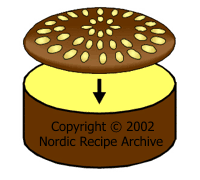
|
|||||||||||||||||||||||
| MAIN RECIPE PAGE |
|
||||||||||||||||||||||
|
KULICH Traditional Russian Easter cake 
Kulich is a traditional Russian Easter dish, popular also among the Finnish Orthodox people. This is an authentic recipe of my great-grandmother Yevfrosinia. Slices of kulich are traditionally served spread with paskha, a Russian Easter dessert made with quark. See additional information about kulich and paskha. 200 ml whole milk Mix saffron with vodka in a small bowl, cover and let stand, preferably overnight. The aroma and colour of saffron will dissolve into the vodka. Bring the milk, eggs and butter to room temperature. Scald, peel, dry and finely grate the almonds. Dissolve the yeast in the lukewarm milk. Stir in 200 millilitres of flour and leave to rise in a warm place. The batter forms "bubbles" on its surface during rising. Beat the egg yolks, 150 millilitres of sugar and vanilla sugar until pale and fluffy. Beat the egg whites until stiff, add the rest of the sugar (50 millilitres) while beating. When the bubbly surface of the batter starts to descend, add the salt, the yolk mixture, the egg whites, the strained vodka, the grated almonds and the softened butter. Add enough flour to get a batter much thinner than regular yeast dough. The batter must not be too thick or hard.
If you do not have a mould tall enough (about 15 - 20 cm at the minimum), you can use any regular, large soufflé or cake mould and line it with parchment paper so that the paper forms a tall rim above the mould, see the picture on right. Fill ¼ of the mould(s) with the batter, cover with plastic or a towel and let the batter rise until it fills about ¾ of the mould(s). Garnish the batter surface with blanched whole almonds and bake at 175 °C for about 40 minutes, or until done. Watch the surface while baking. If it is getting very dark, cover it with foil to prevent it from burning. The kulichi are done, when a cake tester/toothpick inserted in the middle of them comes out clean.
When the kulichi are cool and firm, carefully slice them crosswise into disks, cut to wedges and serve spread with paskha (see the pictures below). In picture on right: paskha on a slice of kulich. Cutting and slicing of kulich
Storing of kulich
Recipe source: family recipe. |
|||||||||||||||||||||||
|
|||||||||||||||||||||||
 Line the bottom and sides of a tall, cylindrical cake mould with (buttered) parchment paper. You will probably need at least two moulds.
Line the bottom and sides of a tall, cylindrical cake mould with (buttered) parchment paper. You will probably need at least two moulds.
 Let the kulichi cool down in their moulds and then very carefully take them out and put on a wire rack. To maintain its delicate structure, old Russian recipes advice to cool the kulich by gently placing it on its side to rest on a down pillow.
Let the kulichi cool down in their moulds and then very carefully take them out and put on a wire rack. To maintain its delicate structure, old Russian recipes advice to cool the kulich by gently placing it on its side to rest on a down pillow.





